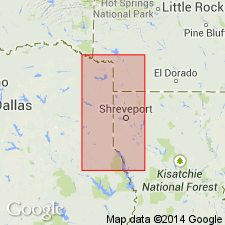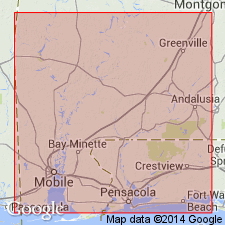
- Usage in publication:
-
- Haynesville Formation
- Modifications:
-
- Not used
Summary:
Haynesville Formation not used. As originally defined: it included as widespread easily identifiable unit the Buckner; its upper part is similar to Cotton Valley Group; it has no regional unconformity at top. Term Buckner Formation (rank raised) applied to all rocks above Smackover Formation and below Cotton Valley Group. Stratigraphic chart.
Source: GNU records (USGS DDS-6; Denver GNULEX).

- Usage in publication:
-
- Haynesville Formation
- Modifications:
-
- Overview
- Dominant lithology:
-
- Anhydrite
- Limestone
- Sandstone
- Shale
Summary:
In the study area, Haynesville can be divided into three distinct units: lower Buckner Anhydrite Member; middle interbedded sandstones, shales, and anhydrites; and upper interbedded carbonate mudstones, dolomitic limestones, sandstones, shales, and anhydrites. Unit probably over 2,800 ft thick in report area. Conformably overlies the Smackover Formation. Kimmeridgian age assigned by Salvador (1987).
Source: GNU records (USGS DDS-6; Reston GNULEX).
For more information, please contact Nancy Stamm, Geologic Names Committee Secretary.
Asterisk (*) indicates published by U.S. Geological Survey authors.
"No current usage" (†) implies that a name has been abandoned or has fallen into disuse. Former usage and, if known, replacement name given in parentheses ( ).
Slash (/) indicates name conflicts with nomenclatural guidelines (CSN, 1933; ACSN, 1961, 1970; NACSN, 1983, 2005, 2021). May be explained within brackets ([ ]).

